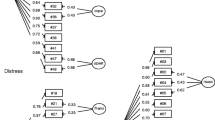Abstract
The Brief Symptom Measure-25 (BSM-25) is a quick and self-administrated measurement, which was originally developed to assess general psychiatric symptomatology. The aim of the present study was to examine the psychometric properties of the Turkish BSM-25. The non-clinical sample consisted of 382 adult participants (71.5% were female) and the clinical sample consisted of 42 adult participants (76.2% were female). To test the psychometric properties of the Turkish BSM-25, we performed a series of analyses including basic explanatory factor analysis, bifactor modeling, bivariate correlation, one-way ANOVA, and ROC analysis. The results indicated that the Turkish BSM-25 had a high level of internal consistency (.92) and acceptable fit indices (RMSEA = .07, CFI = .95 GFI = .97 NNFI = .94). Furthermore, the Turkish BSM-25 successfully discriminated the clinical and non-clinical samples and showed strong validity. The cut-off score was 70.50. In conclusion, the present study provided empirical support for the psychometric adequacy of the Turkish BSM-25 and yielded one general factor.

Similar content being viewed by others
References
American Psychiatric Association. (1994). Diagnostic and statistical manual of mental disorders (4th ed.). Washington, DC: Author.
Blais, M. A., Lenderking, W. R., Baer, L., de Lorell, A., Peets, K., Leahy, L., & Burns, C. (1999). Development and initial validation of a brief mental health outcome measure. Journal of Personality Assessment, 73, 359–373. https://doi.org/10.1207/S15327752JPA7303_5.
Blais, M., Blagys, M. D., Rivas-Vazquez, R., Bello, I., & Sinclair, S. J. (2015). Development and Initial Validation of a Brief Symptom Measure. Clinical Psychology & Psychotherapy, 22, 267–277. https://doi.org/10.1002/cpp.1876.
Boswell, J. F., Kraus, D. R., Miller, S. D., & Lambert, M. J. (2015). Implementing routine outcome monitoring in clinical practice: Benefits, challenges, and solutions. Psychotherapy Research, 25(1), 6–19. https://doi.org/10.1080/10503307.2013.817696.
Byrne, B. M. (1994). Structural equation modeling with EQS and EQS/Windows. Thousand Oaks: Sage Publications.
Çorapçıoğlu, A., Aydemir, Ö., Yıldız, M., & et al. (1999) DSM-IV eksen 1 ruhsal bozukluklarına göre Türkçe yapılanıdırılmış klinik değerlendirmenin güvenirliği. İlaç ve Tedavi Dergisi, 12, 33–36.
Dağ, İ. (1991). Belirti Tarama Listesi (SCL-90-R)‘nin üniversite öğrencileri için güvenirliği ve geçerliği. Türk Psikiyatri Dergisi, 2(1), 5–12.
Gençöz, T. (2000). Pozitif ve Negatif Duygu Ölçeği: Geçerlik ve güvenirlik çalışması. Türk Psikoloji Dergisi, 15(46), 19–26.
Haggerty, G., Kahoud, D., Walsh, E., Ahmed, Z., & Blais, M. A. (2013). A brief inpatient measure of global psychiatric symptom severity: Initial validation of the brief symptom measure-25 for an adolescent inpatient sample. Journal of Nervous and Mental Disease, 201(11), 971–976. https://doi.org/10.1097/NMD.0000000000000040.
Haggerty, G., Siefert, C., Stoycheva, V., Sinclair, S. J., Baity, M., Zodan, J., Mehra, A., Chand, V., Mark, A., & Blais, M. A. (2014). Determining adolescents' suitability for inpatient psychotherapy: Utility of the clinician-rated readiness for inpatient psychotherapy scale with an adolescent inpatient sample. Bulletin of the Menninger Clinic, 78(4), 349–372. https://doi.org/10.1521/bumc.2014.78.4.349.
Kenny DA (2016) Measuring model fit. Retrieved from http://davidakenny.net/cm/fit.htm
Lorenzo-Seva, U., & Ferrando, P. J. (2006). FACTOR: A computer program to fit the exploratory factor analysis model. Behavior Research Methods, Instruments, & Computers, 38(1), 88–91.
Lorenzo-Seva, U., & Ferrando, P. J. (2013). FACTOR 9.2 a comprehensive program for fitting exploratory and semiconfirmatory factor analysis and IRT models. Applied Psychological Measurement, 37(6), 497–498.
Şahin NH, Durak A (1994) K›sa Semptom Envanteri: Türk gençleri için uyarlanmas›. Türk Psikoloji Dergisi, 9(31), 44–56.
The WHO World Mental health Survey Consortium. (2004). Prevalence, severity, and unmet need for treatment of mental disorders in the world health organization world mental health surveys. JAMA, 291(21), 2581–2590. https://doi.org/10.1001/jama.291.21.2581.
Funding
This study was not funded by any institution.
Author information
Authors and Affiliations
Corresponding author
Ethics declarations
Conflict of Interest
On behalf of all authors, the corresponding author states that there is no conflict of interest.
Ethical Approval
All procedures performed in studies involving human participants were in accordance with the ethical standards of the institutional and/or national research committee and with the 1964 Helsinki declaration and its later amendments or comparable ethical standards.
Informed Consent
Informed consent was obtained from all individual participants included in the study.
Rights and permissions
About this article
Cite this article
Gülüm, İ.V., Soygüt, G. Psychometric Properties of the Turkish Brief Symptom Measure-25. Curr Psychol 38, 1558–1563 (2019). https://doi.org/10.1007/s12144-017-9707-4
Published:
Issue Date:
DOI: https://doi.org/10.1007/s12144-017-9707-4




